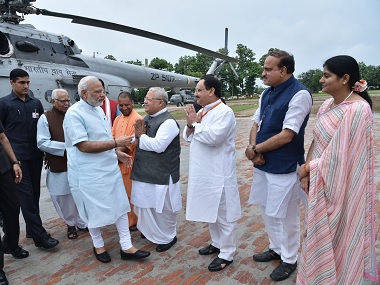At the receiving end of unprecedented, vociferous Dalit angst and attempts by various political forces to mobilise and exploit that anger, a nervous and edgy BJP has launched a desperate firefight.
Although Prime Minister Narendra Modi’s Friday rally in Gorakhpur — one of the most important seats in eastern Uttar Pradesh with over 160 Assembly segments — was scheduled well in advance, the Dalit uprising has added to it an altogether different dimension.
The choice of location and the itinerary of the day provide an interesting glimpse into the way Modi-Amit Shah combine is planning to tackle the 2017 Assembly elections in India’s biggest, most important and the most complex state.
However, if cracking the UP puzzle was tough to begin with, recent events have placed some seemingly insurmountable odds in Modi’s path to replace Congress and consolidate BJP’s position as the pan-Indian party.
From the very outset, since taking office, Modi has been clear in his mission of making BJP a truly national party with footprints across all major states. That must include wresting back power in Uttar Pradesh. The prime minister and party president Amit Shah’s carefully constructed Dalit outreach programme was an important effort towards that end to break caste barriers — seen as a hurdle to Hindu consolidation — and expand the party’s base among the poor, backward and Dalits.
However, that outreach now lies shattered and the entire effort stands nullified with now-deposed BJP UP vice-president Dayashankar Singh’s sexist, misogynist statement against BSP chief Mayawati and the outrage in Gujarat over the public flogging of Dalit youth by members of the ‘gau rakshak samity‘.
Amid this backdrop, it will be interesting to see Modi’s approach. Speculation is that it will be difficult for the Prime Minister to remain silent on the burning issue. Some say he may try to reach out to one of the most important segment of the society and issue conciliatory statements. That, however, seems unlikely.
Why?
It is instructive to note that in the 2014 Lok Sabha elections, the BJP won 66 out of 131 seats reserved for SC-ST candidates in Uttar Pradesh, which is the highest number of reserved constituency seats won by any single largest party ever, since 1991. The BJP retained almost 88 per cent of the seats it had won in 2009.
 This happened despite the fact that the BJP has historically been seen as a ‘savarna’ or upper-caste party. The RSS, since its inception, had tried to dissolve caste barriers in favour of a ‘virat Hindu’ consolidation but as in the organization or its political arm, the upper-caste dominance has not converted into social inclusiveness in practice.
This happened despite the fact that the BJP has historically been seen as a ‘savarna’ or upper-caste party. The RSS, since its inception, had tried to dissolve caste barriers in favour of a ‘virat Hindu’ consolidation but as in the organization or its political arm, the upper-caste dominance has not converted into social inclusiveness in practice.
If that is the case, how did BJP win such a mandate in 2014?
That was possible largely because Narendra Modi’s narrative of development trumped all other narratives, including Mayawati’s focus on Dalit identity. The Prime Minister understands this better that anyone else and therefore, in Gorakhpur, one of the most important cities in eastern UP besides Varanasi, his focus is likely to be on the development narrative again.
In starting the revival of a fertiliser plant and laying the foundation stone of the Aiims in Gorakhpur – two demands which have been pending for over a decade — the Prime Minister will hope to achieve two goals. One, give a boost of development to one of UP’s most backward areas and provide the healing touch to Dalits through action, not words.
The second-biggest industry in the Gorakhpur region after North-Eastern Railway, the fertilizer factory’s sudden closure in 1990 rendered thousands of people jobless. The unit will have machines that will run on gas fuel to produce 3,850 tonnes of Urea per day against its earlier capacity of around 950 tonnes, an important statistic in a still largely agrarian area. The revival of the unit, therefore, uplifts the local economy by creating jobs and also sends across a powerful political message.
Source From : firstpost.com




